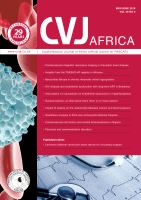

CARDIOVASCULAR JOURNAL OF AFRICA • Volume 29, No 3, May/June 2018
AFRICA
171
in percutaneous mitral valvoplasty with the nucleus balloon.
Arch Inst
Cardiol Mex
2000;
70
: 486–491.
21. Angeles-Valdes J, Uruchurtu Chavarin E, Gomez Cruz A. Mitral valvo-
plasty: The double balloon technique compared with ‘Nucleus’ single
balloon technique (abstract).
Arch Cardiol Mex
2002;
72
: 290–296.
22. Babic UU, Pejcic P, Djurisic Z, Vucinic M, Grujicic SM. Percutaneous
transarterial balloon valvuloplasty for mitral valve stenosis.
Am J
Cardiol
1986;
57
: 1101–1104.
23. Fawzy ME, Hassan W, Stefadouros M, Moursi M, El Shaer F,
Chaudhary MA. Prevalence and fate of severe pulmonary hypertension
in 559 consecutive patients with severe rheumatic mitral stenosis under-
going mitral balloon valvotomy.
J Heart Valve Dis
2004;
13
: 942–948.
Large nuclear cardiology laboratory slashes radiation dose by 60% in eight years
A large nuclear cardiology laboratory has slashed its average
radiation dose by 60% in eight years, according to new research
presented recentlyat the International Conference on Nuclear
Cardiology (ICNC) 2017 and published in
J Am Coll Cardiol:
Cardiovasc Imaging.
The study in over 18 000 patients shows
dose reductions were achieved despite a large number of
obese patients.
‘There has been concern among the medical community
and the public that the radiation from medical diagnostic
tests could increase the risk of cancer, said Professor Randall
Thompson, a cardiologist at the Mid-America Heart
Institute, Kansas City, Missouri, US.
He continued: ‘Although the risk of harm from an
individual nuclear cardiology test is very low – even very
conservative estimates suggest only one in 1 000 extra patients
would develop cancer 20 years later – the cumulative dose
from multiple medical diagnostic tests may be a concern.’
Medical societies advocate getting radiation doses as
low as is reasonably achievable. There are ways to do this
but surveys show that adoption of new technologies, which
cost money, and new testing algorithms, which take more
physician time, has been slow.
This study assessed the impact on radiation dose of
modifying protocols and introducing new hardware (cameras)
and post-processing software in a large nuclear cardiology
laboratory network in Kansas City.
The study included the 18 162 single-photon emission
computed tomography (SPECT) myocardial perfusion
imaging (MPI) studies performed at all four of the Saint
Luke’s Mid-America Heart Institute nuclear cardiology
laboratories from 1 January 2009 to 30 September 2016.
SPECT MPI shows how well blood flows through the muscle
of the heart and is primarily performed to diagnose the
cause of chest pain or to help manage patients with known
coronary artery disease.
Protocols were modified by performing stress-only tests
where possible, which saves the radiotracer dose from the
rest scan. Stress and rest scans are still required in some
patients since shadowing from body parts can look like a
lack of blood flow and two scans can clarify the findings.
Technetium tracers are now used instead of thallium 100%
of the time at one-third of the radiation dose.
Small field-of-view cameras, which have advanced post
processing, and a new generation of camera systems, which
are more sensitive and need less radiotracer injected into
the body, have both been introduced. These camera systems
are equipped with advanced processing which enhances the
nuclear pictures and need less radiation or shorter image
acquisition times. Professor Thompson’s laboratory focused
primarily on reducing the radiation dose.
The average radiation dose fell from 17.9 mSv in 2009 to
7.2 mSv in 2016 and the median dose (the 50th percentile)
dropped from 10.2 to 2.5 mSv. Professor Thompson said:
‘There was a dramatic lowering of the radiation dose with all
of these concerted efforts. The average dose fell by 60% and
the median dropped by 75%.’
‘The average dose had fallen to 5.4 mSv in 2012 but crept
up as we’ve had more obese patients referred in whom we
have to use the higher dose protocols,’ he added. ‘But more
than half of patients now are tested with a low-dose, stress-
only test using the new technology, which is why the median
dose of radiation has fallen so dramatically.’
The average background dose for people living in Europe
and North America from radon underground and cosmic
background sources is about 3 mSv a year. Medical societies
consider higher- and lower-dose tests to be above 10 mSv
and below 3 mSv, respectively. In 2010 the American Society
of Nuclear Cardiology set a target of 9 mSv or less for the
majority of tests.
Professor Thompson said: ‘The majority of studies were
in the high-dose range back in 2009 and now most tests have
a radiation dose that is about a third of the target. This is
despite being referred a larger number of obese patients. In
the last 2.5 years, 17% of patients have needed the large field-
of-view camera as their average body mass index was 46 kg/
m
2
and they were simply too big for the small cameras.’
He concluded: ‘By adopting contemporary protocols and
technologies it is feasible to substantially lower radiation
doses in nuclear cardiology in very large numbers of patients
in real world clinical practice.’
Source
: European Society of Cardiology Press Office

















